

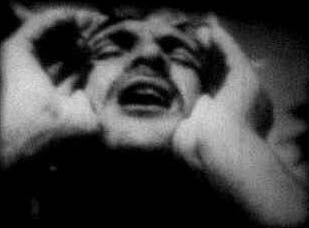
By 1930 Murnau had made three films in America and was thoroughly disillusioned by the process. He longed to make films with the kinds of resources that Hollywood production offered, but to make them on his own terms, independently. With this in mind he formed a partnership with pioneering documentary filmmaker Robert Flaherty, who also had name recognition and longed to create work outside the commercial film industry.
It is difficult to imagine two filmmakers whose work and fundamental view of life could be so different. Murnau's universe is one in which humans act, but are at the mercy of the weather, of the market, of age, of fate. Flaherty's documentaries, like Nanook of the North, are about people adapting to their environment, about people who can succeed despite what fate throws their way. Needless to say, any kind of partnership that may have existed between the two did not last long and though the film is labeled a Murnau-Flaherty Production, Tabu is Murnau's film.
Tabu is the last of the silent films, made two years after the talkie revolution. It was also Murnau's last work. It is the culmination of Murnau's career, containing elements that remind me of many of his other films.

The tale is told through legends and journal entries, like Nosferatu. It is about an ill-starred couple, just as were all Murnau's existing films from Faust on. It is about the power of money to traumatize a life, like City Girl. It shares with Sunrise a focus on water and the threat of drowning, as well as the contrast between an idealized place and a more civilized place. The weight of destiny is broken up by a party that gives the characters an opportunity to momentarily forget their dilemma, as in The Last Laugh. But unlike these other films, Tabu does not have a happy ending. No sudden change, whether in a character, in fate, or in the author gives the film a twist to leave you with a smile. Instead, fate pulls harder, the film pulls no punches, and we are left with the worst we could expect. And then, just before the film was released, Murnau was killed in an automobile accident.
Tabu is the story of Matahi and Reri, two young people in love on an island whose inhabitants still live their lives according to traditions that go back hundreds of years. But a ship comes to their South Pacific island, and on that ship is Hitu, who bears the news that Reri must leave her home to be the sacred virgin on an island far away. She is tabu, a human being that cannot be desired.
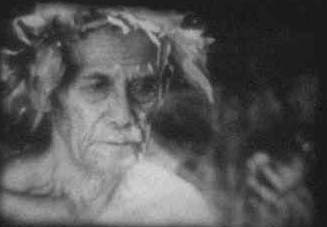
Matahi and Reri flee the island and end up on an island where the influence of the outside world is much stronger. Matahi is an excellent pearl diver, but does not make enough from his pearls to pay the debt that grows because of his generosity. Between debt and Hitu, who finds them, there is little room for them to breathe or endure.
The tale is told with images both lush and realistic, powerful enough to win a Best Cinematography Academy Award for photographer Floyd Crosby, and to influence many filmmakers to come, including Orson Welles (It's All True). The native islanders who acted in the film are treated heroically, shot from low angles and pictured against a sky of dramatic clouds. The film takes its time: twenty minutes go by before the film's story is established. This slow exposition gives us time to luxuriate in the film's people, its South Pacific setting, and the images that translate this far away place and story onto a movie screen. Although Tabu's view of island life might not seem all that scientific today, the film was something of a landmark in ethnography -- in contrast to many other jazz age documentaries that looked at "alien" cultures, Tabu portrays its subjects with a generous amount of respect and artistry.
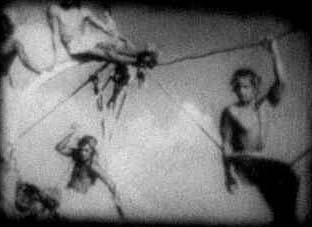
It is significant that Tabu was made as a silent film three years after most of Hollywood had converted to talking pictures. It may have been made silent because of the problems that would have been associated with transporting the clunky early talking film technology to the South Pacific, but I like to think that it was made that way because Murnau wanted it so. In 1931 only two major silent films were released in the United States, Chaplin's City Lights and Murnau's Tabu. In 1940 Chaplin would make his first talking film, but Murnau never would -- which seems appropriate because Murnau was more adept at the art of silent film directing than just about anybody else ever.
Many silent films, including those of D.W. Griffith, are overburdened with intertitles that, in many cases, explain most of the plot and many of the film's nuances. In contrast, as Murnau developed he used fewer and fewer titles, fewer and fewer words, to tell his stories. Both The Last Laugh and Tabu are almost completely without titles, communicating through images, gestures, and simply the way one character looks at another.
In 1931, Tabu must have seemed already out of date, but also perhaps timeless. Its silence and pictorial beauty help to keep it timeless today, and give it a universality that modern films only seem to be able to achieve through violence.
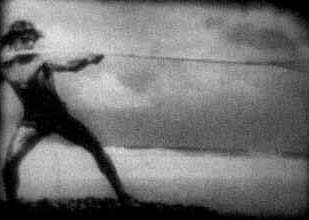
Back to Sloppy Films
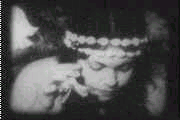
Copyright © 1997 John Akre
http://www.sloppyfilms.com/murnau/tabu.htm